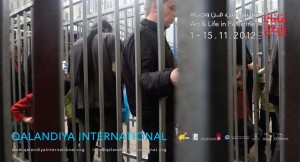Qalandiya International: Art and Life in Palestine
1-15 November 2012
Qalandiya International is the culmination of the vision and work of seven prominent Palestinian cultural institutions that are focused on contemporary art and the Palestine cultural landscape. These institutions consolidated both their resources and creativity to promote Palestine’s contemporary culture to both local and international audiences, while forming artistic links across a fragmented Palestinian geography.
This artistic collaboration includes the following institutions:
- Riwaq
- Al Ma’mal Foundation for Contemporary Art
- A. M. Qattan Foundation
- Palestinian Art Court – Al Hoash
- International Art Academy – Palestine
- Sakakini Cultural Center
- The House of Culture Arts – Nazareth
Qalandiya International will feature 50 international and Palestinian artists who have submitted a diverse group of newly commissioned art projects and presentations with multifarious, interdisciplinary works. The show will be open to all, thus garnering wide public engagement.
A series of high-profile art events, performances, installations, interventions, films, tours, and cultural activities will take place in Palestinian cities across various divides: Jerusalem, Nazareth, Gaza, Ramallah, as well as in several towns and villages in the West Bank. The event will also highlight significant architectural sites with talks and walks, setting the tone for local and international interaction.
Why Qalandiya?
For the past decade, Qalandiya has been associated with the Israeli checkpoint that continues to suffocate the West Bank, disconnecting it from Jerusalem and the rest of the world. This checkpoint has been highly pervasive in the media and in the visual and literary works produced in and about Palestine. Countless stories about daily suffering and subjugation take place there, offering sad but true glimpses of the oppressive regime of the Occupation.
However, “Qalandiya” has other connotations that have been deliberately smeared or totally erased over the years, but which, with a more intimate look, could be uncovered. There is the Qalandiya Airport, for example (or the Jerusalem International Airport as it was initially called), the Qalandiya refugee camp, and Qalandiya village (which the Wall has divided into two separate parts). Qalandiya is where many paradoxes meet. It was the point of connection with the rest of the world until 1967, but has become the symbol of disconnection, isolation, segregation, and fragmentation.
Qalandiya International will utilise the name and its multilayered and contradictory meanings in an event that seeks to expose the true Palestinian brand to the international cultural scene, while giving the world a taste of the symbolic paradox of Qalandiya.


